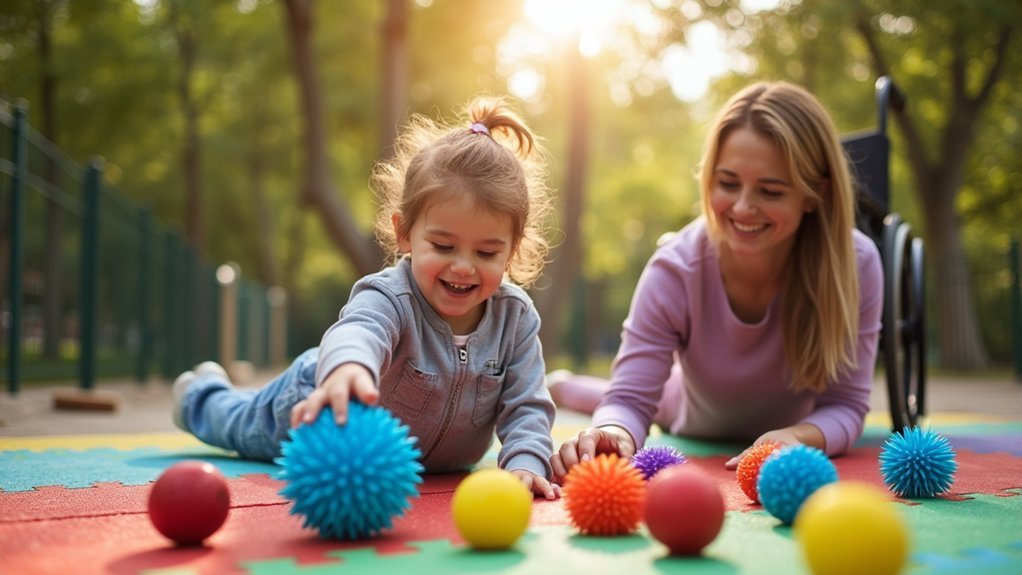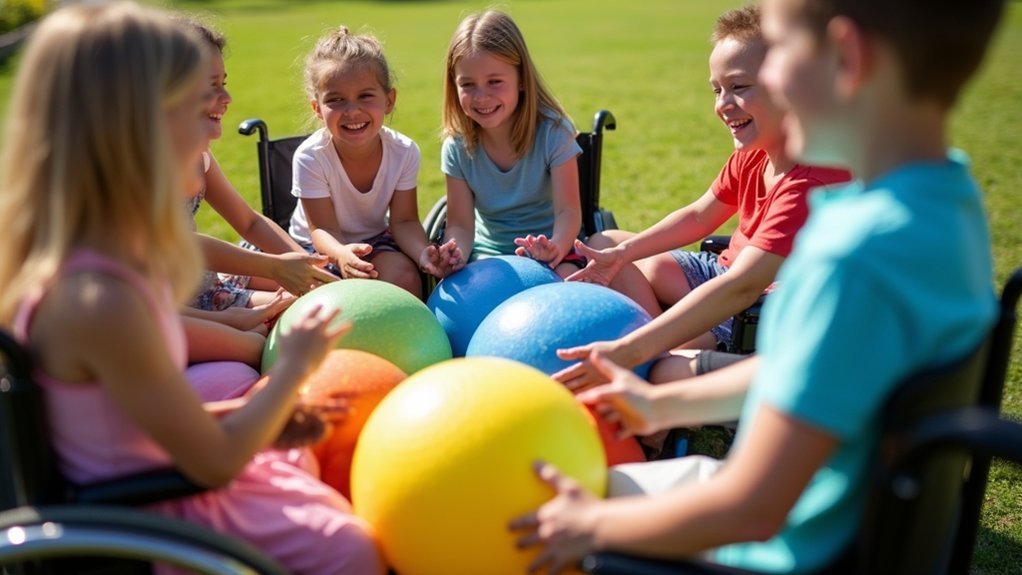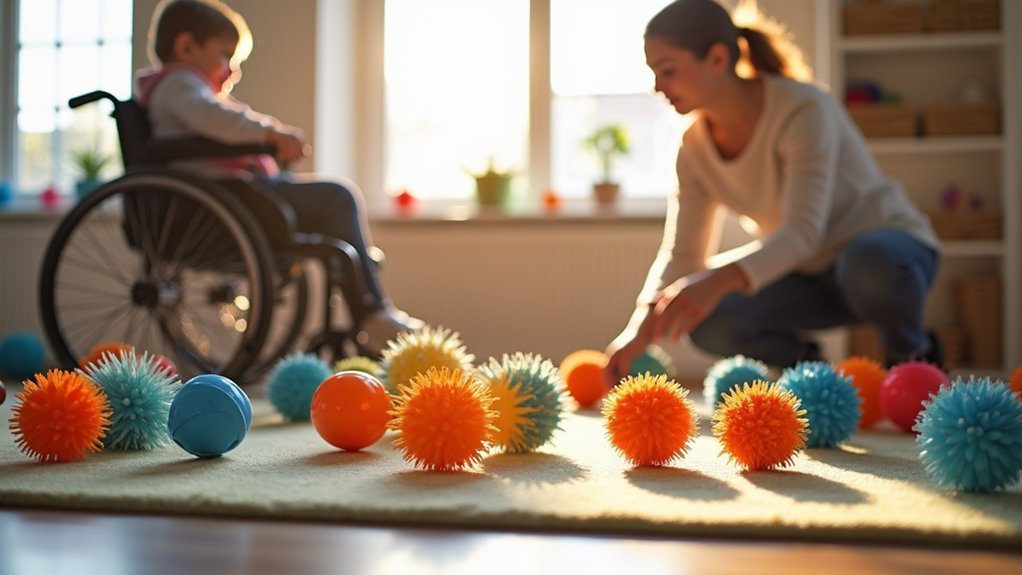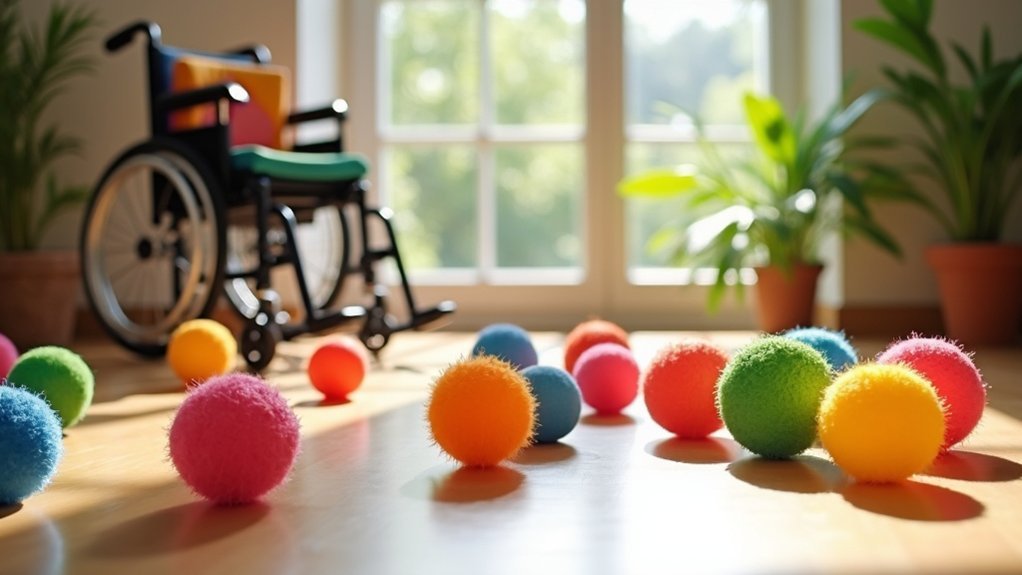Sensory balls offer wheelchair users accessible play options with significant benefits. You’ll find lightweight, textured designs that enhance tactile stimulation while promoting motor skills through gripping, squeezing, and throwing activities. These versatile tools support inclusive group games like modified obstacle courses and target practice, building coordination and social connections. Create safe exploration spaces with soft flooring and adaptive seating to maximize engagement. The right sensory ball can transform physical therapy into enjoyable movement experiences for everyone.
Benefits of Sensory Balls for Wheelchair Users

While traditional play equipment often presents accessibility challenges, sensory balls offer numerous advantages for wheelchair users. These lightweight, textured tools enhance tactile and visual stimulation, making them perfect for sensory exploration from a seated position.
Sensory balls transform accessibility barriers into opportunities for wheelchair users, providing rich tactile experiences without leaving their seated position.
You’ll notice improvement in your child’s motor skills as they grip, squeeze, and roll these versatile balls. The various textures and sizes encourage fine motor development, while throwing and catching activities build upper body strength essential for wheelchair mobility.
Sensory balls also excel as adapted sports equipment, allowing wheelchair users to participate fully in group activities. This fosters valuable social interaction as children engage in collaborative play with peers, developing communication skills and confidence through shared experiences.
Their accessible design guarantees no child feels excluded from the joy of movement play.
Types of Sensory Balls and Their Unique Applications
The world of sensory balls offers remarkable variety, each type bringing unique benefits to wheelchair-accessible play environments.
You’ll find biodegradable natural rubber options like Miniland Sensory Balls that provide both safety and environmental responsibility for wheelchair users of all ages.
Textured balls enhance tactile stimulation, allowing children to explore various surfaces while developing hand-eye coordination.
The nested design—where smaller balls fit inside larger ones—creates adaptable challenges that grow with your child’s abilities.
Lightweight sensory balls are particularly valuable in adapted play settings, as they’re easily grasped and manipulated even with limited mobility.
Their versatility makes them perfect for developmental benefits beyond physical skills, supporting visual processing and spatial awareness while ensuring inclusive participation in movement activities for all children.
Engaging Group Activities With Sensory Balls

Creating inclusive group activities becomes remarkably simple when you introduce sensory balls into wheelchair-accessible play spaces. These versatile tools promote hand-eye coordination and tactile exploration while ensuring everyone can participate regardless of mobility.
Set up a modified obstacle course where participants roll or pass sensory balls as they move around the space. You’ll notice immediate improvements in gross motor skills and muscle strength, particularly for wheelchair users.
Modified obstacle courses with sensory ball activities build crucial motor skills while making movement accessible and enjoyable for wheelchair users.
Games like beanbag toss or partner rolling can be easily adapted for all abilities, making physical education truly inclusive.
The varied textures and vibrant colors of sensory balls naturally stimulate sensory development while encouraging communication between players.
As children work together, they’re not just having fun—they’re building essential social skills and meaningful relationships through engaging group activities that welcome everyone.
Adaptive Ball Games to Enhance Motor Skills
Developing essential motor skills becomes both accessible and enjoyable through specially designed ball games for wheelchair users. These activities not only strengthen coordination but also support mental health through achievement and social interaction.
You’ll find adaptive PE options that improve balance and spatial awareness while building confidence.
- Practice throwing with beanbags aimed at containers of varying sizes, gradually increasing the distance to develop accuracy and upper body strength.
- Increase the challenge by incorporating balloons for hitting exercises that enhance hand-eye coordination vital for daily tasks.
- Explore textures with sensory balls in target games that stimulate tactile awareness while improving precision.
Structured games like boccia offer competitive opportunities that accommodate different abilities while fostering teamwork and communication skills important for social development.
Creating Safe Spaces for Sensory Ball Exploration

When designing play environments for wheelchair users, safety considerations must complement accessibility features to create truly inclusive sensory ball experiences. Incorporate soft surfaces like rubber mats to prevent injuries during active play with sensory balls. Remove obstacles and tripping hazards to guarantee wheelchair users can navigate freely.
| Safety Element | Benefit |
|---|---|
| Soft flooring | Cushions falls during exploration |
| Adaptive seating | Provides stability for limited mobility |
| Non-toxic materials | Guarantees safe exploration for all ages |
Remember to select sensory balls made from natural rubber or other non-toxic materials for safe exploration. Position adaptive seating or supportive cushions strategically around the play area to give wheelchair users comfortable options for engagement. Always maintain adult supervision to assist children and guarantee everyone enjoys a safe, stimulating sensory experience.
Frequently Asked Questions
What Is the Wheelchair Game With the Ball?
You can enjoy several wheelchair-friendly ball games including Boccia, Adaptive Basketball, and “Throw and Catch.” These activities develop coordination and teamwork as you roll, toss, or throw balls between players at varying distances.
How Could You Play With Someone in a Wheelchair at Recess?
You can play ball games by rolling or throwing a sensory ball, set up bean bag tosses, try “Simon Says” with wheelchair-friendly movements, use a parachute together, or enjoy modified tag within accessible boundaries.
What Is the Game Where You Play in a Wheelchair?
You’re likely thinking of wheelchair basketball or wheelchair rugby (“murderball”). Both are popular adaptive sports where you compete from a wheelchair, showing incredible skill and athleticism while following modified rules for accessibility.
How to Play With Someone in a Wheelchair?
To play with someone in a wheelchair, engage them in adapted activities like bean bag tosses, balloon games, or “Simon Says.” You’ll create inclusive fun by adjusting heights, distances, and rules to match their mobility level.
In Summary
You’ve now discovered how sensory balls can transform movement play for wheelchair users. They’re not just toys—they’re gateways to inclusion, sensory development, and joyful participation. Whether you’re strengthening motor skills or fostering social connections, these versatile tools adapt to your needs. Don’t wait to incorporate them into your play spaces. With the right balls and a supportive environment, you’ll create meaningful play opportunities for everyone.





Leave a Reply